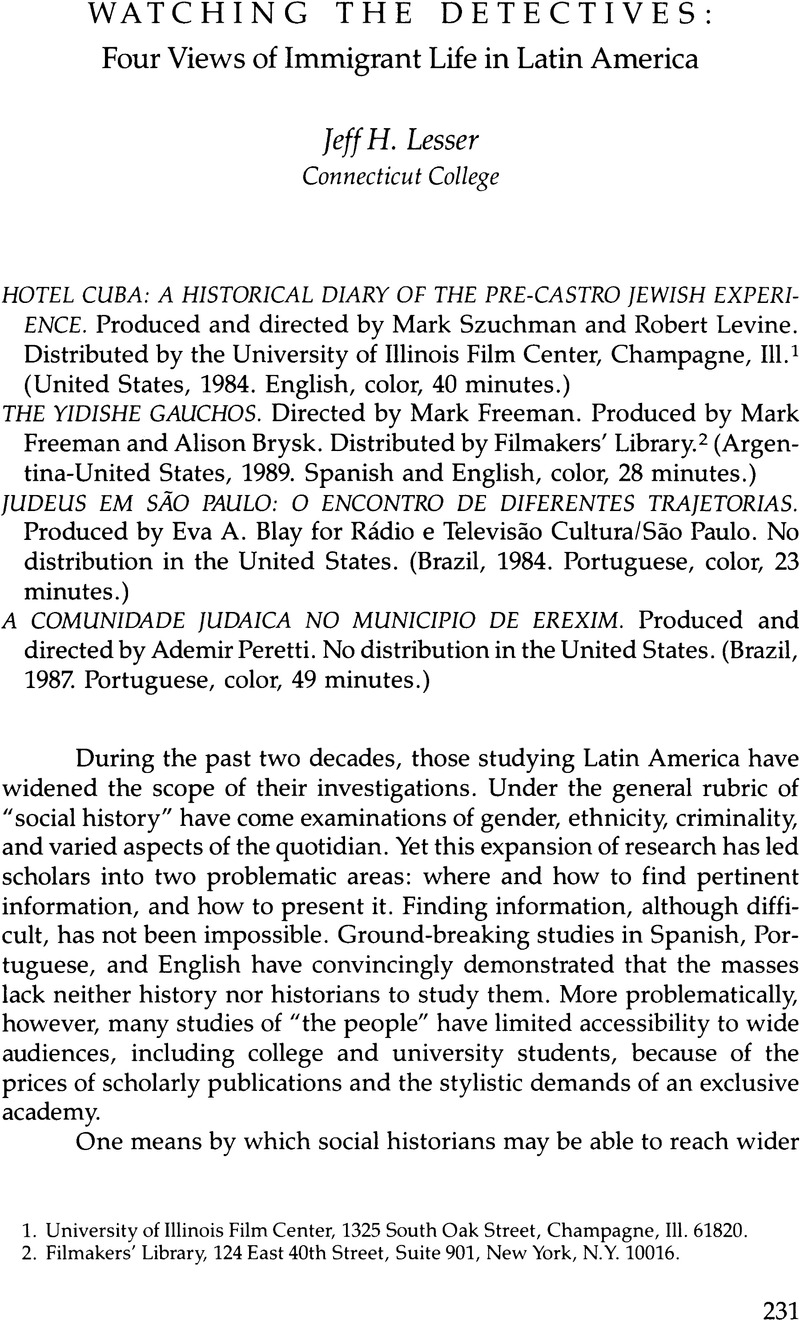No CrossRef data available.
Article contents
Watching the Detectives: Four Views of Immigrant Life in Latin America
Review products
Published online by Cambridge University Press: 12 October 2022
Abstract

- Type
- Review Essays
- Information
- Copyright
- Copyright © 1992 by the University of Texas Press
References
Notes
1. University of Illinois Film Center, 1325 South Oak Street, Champagne, Ill. 61820.
2. Filmakers' Library, 124 East 40th Street, Suite 901, New York, N.Y. 10016.
3. The terms film, documentary, and documentary film will be used interchangeably in this essay.
4. Robert Rosenstone, “Introduction to Film Reviews,” American Historical Review 94, no.4 (Oct. 1989):1031.
5. See, for example, E. Bradford Burns, Latin American Cinema: Film and History (Los Angeles: University of California, 1975); Brazilian Cinema, edited by Randal Johnson and Robert Stam (Austin: University of Texas Press, 1988); Cinema and Social Change in Latin America: Conversations with Filmmakers, edited by Julianne Burton (Austin: University of Texas, 1986); Liz Kotz, “Unofficial Stories: Documentaries by Latinas and Latin American Women,” The Independent, Film and Video Monthly 12, no. 4 (May 1989):21–27.
6. Magnus Mörner, Adventurers and Proletarians: The Story of Migrants in Latin America (Pittsburgh, Pa.: University of Pittsburgh Press, 1985); Thomas Holloway, Immigrants on the Land: Coffee and Society in São Paulo, 1886–1934 (Chapel Hill: University of North Carolina Press, 1980); Judith L. Elkin, Jews of the Latin American Republics (Chapel Hill: University of North Carolina Press, 1980); and Hernán Asdrúbal Silva et al., Bibliografía sobre el impacto del proceso inmigratorio masivo en el Cono Sur de América (Mexico City: Instituto Panamericano de Geografía e Historia, 1984).
7. Warren Dean, The Industrialization of São Paulo (Austin: University of Texas Press, 1969); Nicolás Sánchez-Albornoz, The Population of Latin America (Berkeley and Los Angeles: University of California Press, 1974); and James R. Scobie, Buenos Aires: Plaza to Suburb, 1870–1910 (New York: Oxford University Press, 1974).
8. Other documentaries on the Latin American Jewish experience are Argentina's Jew: Days of Awe (United States) and Sosua (United States). Both are available from Ergo Media Inc., P. O. Box 2037, Teaneck, New Jersey 07666.
9. See Elkin, Jews of the Latin American Republics; Haim Avni, Argentina y la historia de la inmigración judía, 1810–1950 (Jerusalem: Editorial Universitaria Magnes, 1983); James Scobie, Revolution on the Pampas (Austin: University of Texas Press, 1964); S. Adler-Rudell, “Moritz Baron Hirsch,” Leo Baeck Institute Yearbook 8 (New York: Leo Baeck Institute, 1963); and Jeff Lesser, “Pawns of the Powerful: Jewish Immigration to Brazil, 1904–1945,” Ph.D. diss., New York University, 1989.
10. Memorandum and Articles of Association of the Jewish Colonization Association of September 19, 1891 (London: Jewish Colonization Association, 1891).
11. Domingo Faustino Sarmiento, Life in the Argentine Republic in the Days of the Tyrants; Or, Civilization and Barbarism (New York: Hafner, 1970), 28.
12. A short newsreel, Bound for Nowhere: The St. Louis Episode, was produced by the American Jewish Joint Distribution Committee in 1939. It is available from the National Center for Jewish Film, Brandeis University, Lown 102, Waltham, Mass. 02254.
13. Sergio Della Pergola, “Demographic Trends of Latin American Jewry,” in The Jewish Presence in Latin America, edited by Judith L. Elkin and Gilbert W. Merkx (Boston, Mass.: Allen and Unwin, 1987), 92.
14. For example, The Yidishe Gauchos has been exhibited internationally and has won several awards, including the Latin American Studies Association's “Award of Merit.” Also, Robert Levine has been researching the Jewish experience in Cuba for the past four years and has completed a manuscript entitled “Tropical Diaspora: Jewish Life in Cuba, 1902–1991.”




